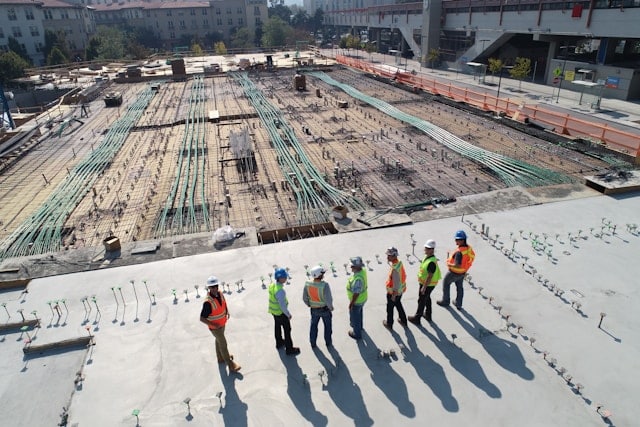As we step into the future, the construction industry faces an imperative challenge: to transition towards sustainable building practices. The need for this shift is driven by the increasing environmental impact of traditional construction methods, which contribute significantly to carbon emissions and waste production. Sustainability is no longer an added benefit, but a crucial aspect of construction, and it is the responsibility of every company in this industry to play their part. So, what are the best practices for UK construction companies to promote sustainable building?
Embracing Green Building Materials
The first step in establishing sustainable construction practices involves a fundamental change: the materials you use. Green building materials, such as recycled steel, bamboo, and straw bales, have a lower environmental footprint than traditional materials. They require less energy to produce and often come from renewable sources, helping to reduce the industry’s carbon footprint.
This might interest you : How Can UK Independent Publishers Use Analytics to Drive Content Strategy?
These materials are not just beneficial for the environment; they also have practical advantages. For instance, they are generally more durable and require less maintenance than traditional materials. Furthermore, using green materials will demonstrate your commitment to sustainability to your customers, potentially giving you a competitive advantage in the increasingly eco-conscious market.
Incorporating Energy-Efficient Designs
The design of a building plays a crucial role in its environmental impact. An energy-efficient design, which takes into account factors like insulation, natural light, and ventilation, can drastically reduce the energy consumption of a building over its lifetime.
Also read : How Can UK Jewelers Utilize Instagram to Increase Sales?
One technique that has proven successful in promoting energy efficiency is passive design. This approach involves orienting a building to make the most of natural light and heat, using high-quality insulation to reduce heat loss, and incorporating features like green roofs and walls to further improve energy performance.
Advancements in technology have also opened up new possibilities for energy-efficient design. For example, Building Information Modelling (BIM) allows architects to simulate the energy performance of their designs, making it easier to optimize them for energy efficiency.
Reducing Construction Waste
Construction is a major contributor to waste production, with the UK alone producing 120 million tonnes of waste every year. However, a significant portion of this waste can be avoided through better waste management practices.
One such practice is the use of prefabricated components, which are constructed off-site and then transported to the construction site. This method not only reduces waste, but also minimizes the disruption caused by construction activities. Another practice is the reuse and recycling of materials, which can significantly reduce the demand for new materials.
Moreover, waste can be minimized through careful planning and coordination. By using software tools like BIM, you can accurately predict the amount of materials needed for a project, reducing the likelihood of over-ordering and subsequent waste.
Implementing Environmental Management Systems
Environmental Management Systems (EMS) are frameworks that help organizations manage their environmental responsibilities in a systematic and consistent manner. For construction companies, implementing an EMS can be a powerful tool in promoting sustainable practices.
An EMS helps companies identify their environmental impacts, set objectives to reduce these impacts, and monitor their progress towards achieving these objectives. By bringing sustainability into the heart of your business operations, an EMS can drive continuous improvement and help you stay ahead of the ever-evolving environmental legislation.
In the UK, one of the most widely recognized EMS is the ISO 14001 standard. This standard is based on the plan-do-check-act methodology and provides a practical framework for managing your environmental responsibilities.
Engaging with the Local Community
Finally, promoting sustainable building is not just about what you do on your construction sites; it also involves how you engage with the local community. By involving local people in your projects, you can help foster a culture of sustainability and create a positive impact beyond the physical structures you build.
One way to engage with the community is through apprenticeships and training programs. These initiatives can provide local people with the skills needed to work in the sustainable construction industry, thereby creating new employment opportunities. Another approach is to support local sustainability projects, such as community gardens or renewable energy installations. This not only benefits the community, but also enhances your company’s reputation as a responsible and sustainable business.
In conclusion, promoting sustainable building requires a comprehensive approach that covers all aspects of your operations, from the materials you use to the way you engage with your community. By embracing these practices, you can help shape the future of sustainable construction in the UK and beyond.
Using Social Media for Sustainability Advocacy
In the digital age, social media platforms are increasingly becoming useful tools for construction companies to promote sustainable building. With billions of users worldwide, platforms like Facebook, Twitter, Instagram, and LinkedIn, among others, can reach a wide audience, making them ideal for sharing information about sustainable construction practices and projects.
A robust social media presence can show your firm’s commitment to sustainability and provide a valuable platform for educating the public about the importance of green building materials, energy-efficient designs, and waste reduction. The goal is to foster a dialogue about sustainability in the built environment and the role construction companies play.
Companies can use social media to showcase case studies of successful sustainable projects, share posts about eco-friendly building materials, and engage potential clients through interactive features. They can also utilise these platforms to promote sustainability-related events, such as webinars, workshops, and conferences.
Moreover, social media can be a platform for partnering with other ecological initiatives. Collaborating with non-profit organisations, government entities, or other construction companies can increase reach and impact. Together, you can work towards a common goal of a greener future.
Improving Air Quality in Construction Sites
The construction industry has a critical role to play in addressing air pollution, which is a major environmental concern. Construction activities can significantly impact air quality due to the emission of pollutants from machinery and the use of certain building materials.
A focus on eco-friendly construction practices can help to mitigate this issue. For example, companies can opt to use low-VOC (Volatile Organic Compounds) materials in their construction projects, which have less harmful impacts on air quality. They can also invest in machinery and equipment that use cleaner energy sources, reducing their emissions.
Furthermore, construction companies can implement air quality monitoring systems on their sites. This can help in identifying any potential problems and taking immediate action to address them. Regular maintenance checks on equipment can ensure they are running as efficiently and cleanly as possible.
In addition, construction companies can contribute to improved air quality by incorporating solutions into their designs. This could include features like green roofs and walls, which can help to filter pollutants and improve the air quality in urban environments.
The importance of incorporating air quality considerations into construction practices cannot be overstated. Not only does it contribute to environmental sustainability, but it also helps to ensure the health and wellbeing of construction workers and the wider community.
Conclusion
In conclusion, the call to action for the UK construction industry is clear: it’s high time to embrace sustainable practices at every level of operation. Whether it’s through using green building materials, incorporating energy-efficient designs, reducing construction waste, implementing Environmental Management Systems, engaging with the local community, advocating on social media, or improving air quality on construction sites, every step matters.
Promoting sustainable building is not a trend but a necessity. It’s about ensuring that the construction projects we undertake today contribute to a sustainable and eco-friendly built environment now and in the future. By adopting and promoting these practices, construction companies can lead the way in shaping a greener future, setting a benchmark for other industries to follow. The challenge is significant, but with commitment and innovation, it is an achievable goal.






